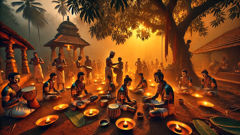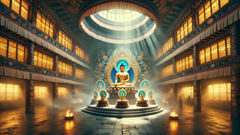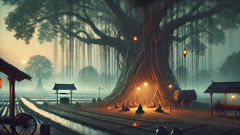Introduction
The coastal wind carries salt and sandalwood, and in the dusk dust of Tulu Nadu villages the sound of drums moves like tide beneath the banyans. When the monsoon light thins and the riverbanks mirror the sky, families gather where the temple lamp is already breathing. The Buta Kola begins not as a spectacle but as a remembering: an invitation across generations, a summons that threads the living and the dead. In that first hour of twilight, the village breathes and waits. Elders sit on verandas, children press their faces against wooden railings, women tilt heads beneath the shadow of saree pallus, and the men who will become masks move with a hush that is almost prayer. Someone polishes cymbals; someone tightens a waistband; someone smooths turmeric paste into intricate spirals across a brow. The preparation is ritualized—ritual as language. As the first gongs strike, the air changes. Scent of burning camphor folds into the beat of leather and metal. A singer intones a line of the old stories—of heroes who walked the fields, of rain-makers and guardians, of wrongs that were set right by a blade of cane or a stern word from a spirit. These stories are both instruction and invocation. The dancer steps into a circle of oil lamps, the paint on his face a map of the other world: red for anger turned to protection, white for purity, black to cut through illusion. The costume is heavy with meaning—cotton skirts and bead necklaces, mirrors and painted motifs that flash like constellations when the performer turns. In this place, flesh can be a vessel. When the drums reach a certain pitch and the singer’s voice hits that particular, familiar cadence, the dancer’s posture loosens; a different set of eyes seems to look through him. People lean forward. They whisper names—Koti Chennayya, Pilichanda, protective butas whose histories are told and retold at harvest tables and funeral fires. For a few hours the village watches gods walk and arguments dissolve. The Buta Kola is not merely ceremony. It is a social compass, a courtroom, a healing house and a theatre all at once. It stitches memory into the present by permitting the sacred to enter a mortal frame and adjudicate disputes, bless new beginnings, and remind a changing world that even now the old forces are near.
Origins and Stories: How the Buta Kola Came to Be
Long before the conveniences of highways and the hum of modern towns, the communities of Tulu Nadu lived close to the land and to each other’s reputations. Folk accounts say the first Buta Kola came into being when a wandering guardian spirit intervened on behalf of a harvest threatened by drought. That spirit—spoken of in different hamlets by different names—was neither wholly benevolent nor simply malevolent; it was a moral force that needed recognition. The village elders, wanting to bind the spirit to the people’s welfare, organized a ritual to honor and pacify it. In time the ritual took shape: songs to call the spirit, paints and costumes to represent its force, and a human agent who would be the intermediary. From then on, any grievance that could not be settled with words might be laid before the Buta. If a field went barren, if a family felt a misfortune had been visited upon them by envy or ill-will, the Buta was summoned. Over centuries the lineages of these spirits multiplied. Heroes who had died defending a village became butas, as did mythic protectors and river and tree guardians. Oral historians recited genealogies linking certain clans to particular butas: these lineages managed ritual rights, maintained the shrines, and kept the stories accurate enough that a younger generation could call a figure to mind and recognize its iconography.
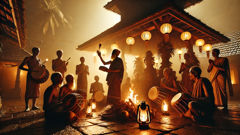
The stories themselves are nuanced, filled with episodes of bravery and folly. One commonly told tale concerns a butcher-turned-deity whose name is now invoked to settle thefts on market days. He was once a mortal who punished a cheating merchant; legend says his anger was so righteous that after his death the villagers continued to consult him for justice. Another legend speaks of a sister and brother who sacrificed themselves to stop a plague, and their names are chanted on wedding days to bless new unions. These narratives are part myth, part social record—oral law that contains not only supernatural acts but also moral lessons about greed, loyalty, and the local sense of justice. They survive in lyrical songs that performers recite before the possession. Even younger listeners who cannot always repeat the genealogies will hum the tunes and know which beats signal an intercession by a particular spirit.
The performance of origin stories during a Buta Kola is deliberate. It matters which verses are sung at dusk, which prophecies are declared when a dancer first feels the spirit's presence. Ritual specialists—those who have the right to recite and to mark the dancer—are trained in the cadence and the pauses that usher in the transformation. The recital is a bridge: it reminds villagers who they are and what the spirits expect. It is also a living archive. Where written records are rare or absent, the Buta Kola holds history in its rhythms, keeping memory of disputes resolved, epidemics survived, and alliances forged. Older participants sometimes speak of the Buta Kola as a kind of public ledger, an informal court where testimony offered in the voice of a deity settles feuds more stubborn than any counsel. This is where the ritual’s cultural weight is clearest: it is not only about the spectacle of possession but about a functioning social mechanism—both an aesthetic and an ethical institution that has persisted because it answers communal needs.
The language of the songs and the iconography of the costumes are local genius. Colors and patterns mean something particular; a stripe might indicate a warrior spirit, a row of mirrors might ward off envy. The dance steps are neither random nor pure entertainment. They map the spirit’s mythic movements: an opening sweep that gathers stray fortunes, a sudden stomp that severs a malicious tie, a low bow that returns a child’s illness to the earth, where it will be turned into compost and eventually into crops. These gestures are mnemonic devices—movements that compress entire sermon-like stories into physical form. The cumulative effect is a communal memory in motion, an embodied archive humming with the ordinary urgencies of life and death.
Possession, Performance, and the Moral Order
Possession in Buta Kola does not occur in a vacuum. Before any dancer is chosen, a negotiation takes place between families who hold ritual rights, the village council, and the priest or custodian of the shrine. The dancer is often someone with a predisposition for the role: a man or woman who has trained in the steps, who has a steady frame, who knows when to let a voice go thin and when to pull it back. In some places the chosen performer claims descent from a hereditary custodial family; in others, community decisions determine who will carry the mantle. The selection matters because the community must trust the performer to act as conduit without abusing the role. Once chosen, the performer undergoes a sequence of preparations—fasting, prayers, the deliberate application of pigment in elaborately designed patterns that locate the spirit within the body. Helpers set up the shrine: fresh flowers, a coconut split and smeared with turmeric, a mound of rice, pieces of areca nut arranged like offerings. The air fills with incense. As the music begins, the performer tightens a waistcloth and places mirrors upon the chest to reflect harmful glances. The first phase of the dance is identification: a slow procession in which the performer moves through specific, symbolic steps meant to anchor the spirit’s presence. The audience watches not as a crowd watching an actor but as citizens watching a magistrate arrive at the bench.
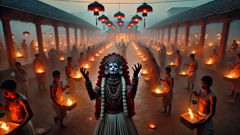
As the tempo accelerates, the dancer’s posture alters. Muscles relax into hallmarks of another will; the eyes widen, and a voice that is not the dancer's may speak in clipped, ancient syntax. The Buta now adjudicates. People file forward with grievances: a boundary dispute, a theft, a paternity claim, an illness. The spirit listens and then decides. Its pronouncements are decisive—sometimes startlingly practical. A Buta might demand reparations in goods or labor rather than blood; it may instruct two families to share water rights, or insist that a particular tree be spared. When the judgment is delivered, it carries moral weight not because of a mystical imprimatur alone but because the community has consented to respect it. Social order is thus maintained through ritualized power, and the ritual ensures that the power remains accountable to the people who invoked it. The Buta’s voice can soothe and can terrify; it can banish misfortune or reveal a hidden truth. For many villagers, the Buta’s verdict is more effective than any secular court simply because the social sanctions for defying a spirit’s order are immediate and collective.
Healers and counselors work alongside the performance. When injury or sickness is brought before the Buta, the spirit’s approach to remedy can be both spiritual and practical: a blessing to restore hope, a direction to a particular herb or healer, or counsel that realigns relationships within the family to reduce psychosocial strain. The ritual becomes therapy, law, and theater in one continuous thread. What also distinguishes Buta Kola is its ability to absorb contradictions. It can sanction violence in stories while advising restraint in practice. It speaks in language that blends mythic absolutes with pragmatic compromises. In a world where modern institutions sometimes fail to reach the village’s daily realities, the Buta acts as an adaptable institution that keeps social fabric intact.
Watching a Buta Kola is to experience the elasticity of tradition: how an ancient form can bend to meet new questions. Electricity and smartphones have altered some timings, and sometimes official court notices now sit alongside shrine offerings. Yet the essence is remarkably resilient. Even younger villagers, who go to cities for work and return with unfamiliar habits, still pause their lives for a Kola. They return because the ritual does what an online decision cannot: it gathers the body of the village and says, with all the authority of shared history, ‘This is how we stand together.’ The spectacle of painted faces and swinging skirts is compelling, but the deeper draw is the ceremony’s capacity to make a moral universe visible—a place where consequences are immediate, where social bonds are repaired in public, and where the sacred is not abstract but involved in the mundane upkeep of human relations.
Conclusion
The Legend of the Buta Kola Spirits is not only a catalogue of images and rites; it is a living repository of values that have allowed Tulu Nadu communities to navigate uncertainty for generations. In the rough weather of human life—when crops fail, when jealousies flare, when illness visits—the Buta Kola performs a kind of social triage, combining ritual, narrative, and adjudication into a single, powerful practice. Those who witness it seldom walk away untouched: they carry home the memory of a night when ordinary bodies became thresholds to the sacred, when paint and drumbeat opened a passage that settled disputes, handed out guidance, and stitched people together again. Modernity will continue to press at the edges of tradition, and some rituals will shrink or change as populations move and institutions evolve. Yet, for now, the Buta Kola endures precisely because it does more than memorialize the past. It reactivates it. It makes ethics palpable, renders history audible, and binds community with rhythms that feel at once ancient and immediately necessary. In Tulu Nadu, the lamps are still lit, the songs still rise, and when the drums find that ancient cadence, the butas walk among the living once more—firm reminders that a people’s soul can be found where story, song, and communal care meet.

